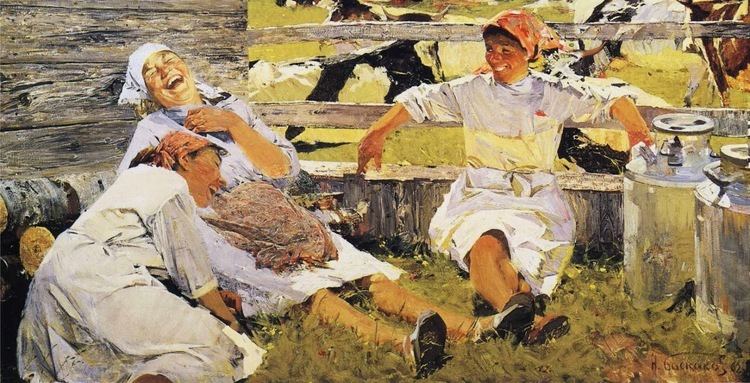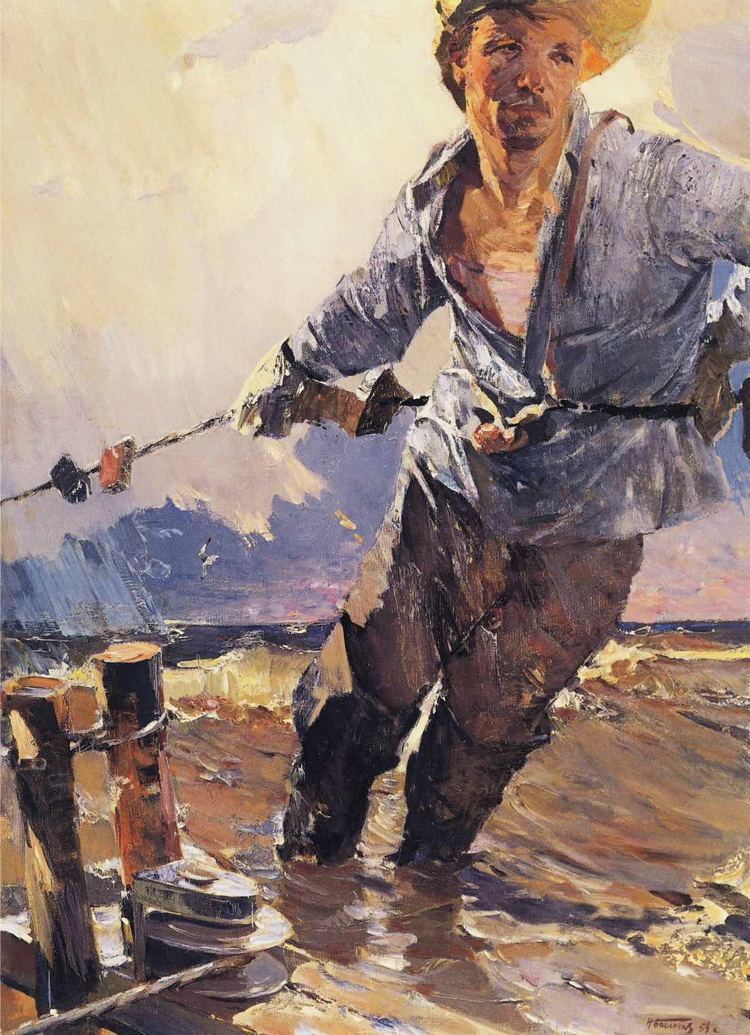Nationality Russian Movement Realism Period Realism | Name Nikolai Baskakov Known for Painting Role Artist | |
 | ||
Born May 8, 1918 Astrakhan, Soviet Russia Died October 14, 1993, Saint Petersburg, Russia | ||
Education Imperial Academy of Arts | ||
Nikolai Nikolaevich Baskakov (Russian: Никола́й Никола́евич Баска́ков; May 8, 1918, Astrakhan, Soviet Russia – October 14, 1993, Saint Petersburg, Russia) was a Soviet, later Russian, painter, a member of the Saint Petersburg Union of Artists (before 1992 known as the Leningrad branch of Union of Artists of Russian Federation), who lived and worked in Leningrad, regarded as one of the leading representatives of the Leningrad school of painting, most famous for his genre and portrait painting.

Biography

Nikolai Nikolaevich Baskakov was born May 8, 1918 in a village seven kilometers from the Astrakhan city on the Volga River. His father, Nikolai Evlampievich Baskakov was a carpenter, his mother Evdokiya Vasilievna was a housewife raising children their children- nine sons and two daughters.
In 1933–1939 Baskakov studied under the famous Russian art educator Pavel Alekseevich Vlasov in the Astrakhan School of Art. In 1939 he was drafted into the Red Army, having served in the Far East. There, in 1943, he participated in an art exhibition, his work "Khabarovsk, the year 1942" was one among the thirty-eight works of artists of Khabarovsk that had been presented in the exhibition in Moscow.
In 1945 Nikolai Baskakov went to Leningrad and entered the Department of Painting of the Leningrad Institute of Painting, Sculpture and Architecture, where he studied under Leonid Ovsannikov, Boris Fogel, Genrikh Pavlovsky, and Alexander Zaytsev.
In 1951 Nikolai Baskakov graduated from the Ilya Repin Institute of Arts under the supervision of the Boris Ioganson's workshop, together with Alexei Eriomin, Mikhail Kaneev, Maya Kopitseva, Anatoli Levitin, Avenir Parkhomenko, Arseny Semionov, Mikhail Trufanov, Boris Ugarov, and other young artists of the time. His graduation work had been the historical painting "Lenin and Stalin in Smolny".
Since 1951, Baskakov had been a permanent exhibitor of the Leningrad Art exhibitions, where he presented his work among with others pieces of art by the leading painters of fine arts in Leningrad. He painted historical paintings and war-depicting works, genre scenes, portraits, landscapes and made sketches of every-day life. Baskakov worked in the technique of oil painting. In the same year together with artists Grigory Chepets and Mikhail Trufanov he performed his first large order - the painting "Presenting of the Order of Lenin to the Kirov factory", for which he was admitted as a member of the Leningrad Union of Soviet Artists.
In 1950-1960s, Baskakov also created paintings "On a floating fish factory" (1954), "A Winter" (1955), "Masha" (1956), the "A Letter" (1957), "On the River" (1958), "Grandma and granddaughter", "A Teacher", "Summer" (all 1960), "Pig farm workers", "Chiefs on the farm" (both 1961), "Plasterers" (1964), and others. Notable among these are the paintings, which dates back to the dramatic events of wartime. Baskakov creates images filled with deep domestic drama, among them paintings "Music" (1957), "During the war", (1967), "On the Russian land" (1968), "A Victory" (1974), "Conversation with son", "Day of Victory" (both 1980).
In 1956 Baskakov created the painting "Lenin in the Gorki", where Lenin was depicted sitting in a chair on a summer day in the garden. The author's approach is seen in large genre painting "Lenin in the Kremlin" (1960). Later Baskakov created the paintings "Lenin on vacation" (1970) and "On New Year's celebration in Gorky" (1972).
Baskakov gained fame also as a portraitist. Among his the best known works created in this genre were "Guitarist" (1949), "Portrait of a Mother" (1955), "Portrait of a tractor driver" (1956), "Portrait of a Fisherman" (1959), "The Son of a shepherd" (1962), "Girl with willows" (1967), a large series of portraits of the workers of the Kirov factory, created in 1960–1980 years, "Schoolgirl", "Hunter Grisha Eriomin" (both 1971), "Grandma with the grandchildren" (1972), "The guy from Dudinka", "Old Nganasanka" (both 1973), "A worker Fadeev with pupils", "Collective Farm keeper Mitrich" (both 1975), "Portrait of an old Uzbek woman" (1977), "Sisters" (1979), "Portrait of a welder" (1980), "Portrait of Vasily Shukshin", "Portrait of the Artist" (both 1984), "A Group portrait of Kirov factory workers" (1985), "A Portrait of the poet Nikolai Rubtsov" (1988), and others.
For the art of Nikolai Baskakov typical appeal to the themes of large public sound and to the image of a contemporary, disclosed in a picture-portrait. He was most known for his impressive portraits of contemporaries painted in realistic style.
The West discovered the art of Nicholas Baskakov in 1989, when his portraits and genre paintings were first shown in Paris at the auctions of the Leningrad school artists. Subsequently many of his works were acquired by American private collections.
In 1991 Saint Petersburg publishing house "Khudozhnik RSFSR" issued a monograph by V. Kirillov, devoted to creation of Nikolai Baskakov. Nikolai Baskakov was elected a full member of Peter's Academy of Sciences and Arts. In 1989-1992 his paintings were exhibited in France on auctions of Russian paintings L'École de Leningrad and others.
Nikolai Nikolaevich Baskakov died on October 14, 1993, in Saint Petersburg at the seventy-six year of life. His paintings reside in State Russian Museum, in Art museums and private collections in the Russia, Japan, in the U.S., Germane, England, France, and other countries.
